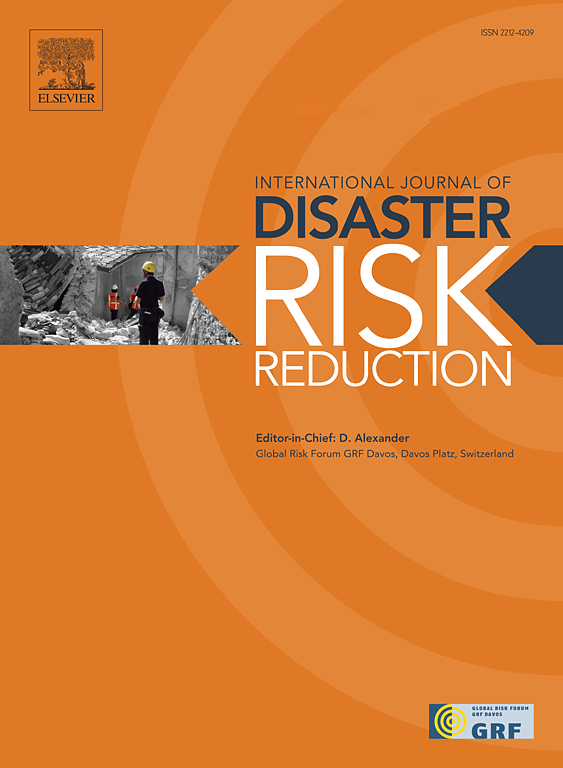与威胁无关的弹性:框架和应用
IF 4.2
1区 地球科学
Q1 GEOSCIENCES, MULTIDISCIPLINARY
International journal of disaster risk reduction
Pub Date : 2025-04-30
DOI:10.1016/j.ijdrr.2025.105535
引用次数: 0
摘要
关键的基础设施并非坚不可摧。基础设施系统和环境之间的相互依赖关系会给脆弱地区带来复杂的后果,但可以利用这些因素来最大限度地提高运营效率、恢复能力和长期可持续性。无论是新出现的还是系统性的威胁,都已经超越了历史规范,暴露了针对特定风险的恢复能力方法的局限性。从本质上讲,这些方法依赖于预定义的场景,这些场景无法捕捉级联故障、新威胁组合以及风险随时间的动态演变的全部复杂性,特别是在环境受到影响的情况下。这在规划、响应和恢复方面留下了严重的空白,因为围绕特定危害设计的系统通常无法适应超出其狭窄定义参数的中断,从而导致意想不到的脆弱性和较慢的恢复轨迹。我们提出了一种向威胁不可知弹性的范式转变,强调通过模块化、分布式、多样性和可塑性来适应不可预见的危险。这些原则通过使关键功能能够在不可预测的挑战下持续存在来促进系统范围的健壮性。该框架还考虑了复原力战略与环境结果之间的相互依赖关系,确保了对不可预见危险的适应性与可持续性目标之间的平衡。弹性特征,如模块化设计和分布式系统,资源使用的形状模式,能源效率,以及跨系统的生态影响。通过确定评估和优化这些权衡的方法,我们为设计基础设施提供了可操作的见解,同时增强弹性并最大限度地减少环境负担。在实际应用中为这些原则建立方法论基础以防止沉没成本和过度限制操作程序方面存在挑战。本文章由计算机程序翻译,如有差异,请以英文原文为准。
Threat-agnostic resilience: Framing and applications
Critical infrastructure is not indestructible. Interdependencies between infrastructure systems and the environment compound consequences at vulnerable locations but can be harnessed to maximize operational efficiency, recovery capability, and long-term sustainability. Threats, both emergent and systemic, have propagated beyond historical norms, exposing the limitations of hazard-specific resilience approaches. These approaches, by their nature, rely on predefined scenarios that fail to capture the full complexity of cascading failures, novel threat combinations, and the dynamic evolution of risks over time, especially in the cases where environment is affected. This leaves critical gaps in planning, response, and recovery, as systems designed around specific hazards are often unable to adapt to disruptions that fall outside their narrowly defined parameters, resulting in unanticipated vulnerabilities and slower recovery trajectories. We propose a paradigm shift toward threat-agnostic resilience, emphasizing adaptability to unforeseen hazards through modularity, distributedness, diversity, and plasticity. These principles foster system-wide robustness by enabling critical functions to persist despite unpredictable challenges. This framework also accounts for the interdependencies between resilience strategies and environmental outcomes, ensuring that adaptability to unforeseen hazards is balanced with sustainability goals. Resilience characteristics, such as modular design and distributed systems, shape patterns of resource use, energy efficiency, and ecological impacts across systems. By identifying methods to assess and optimize these trade-offs, we provide actionable insights for designing infrastructure that simultaneously enhances resilience and minimizes environmental burdens. Challenges exist in developing methodological foundations for these principles within practical applications to prevent sunk cost and over-constraining operational procedures.
求助全文
通过发布文献求助,成功后即可免费获取论文全文。
去求助
来源期刊

International journal of disaster risk reduction
GEOSCIENCES, MULTIDISCIPLINARYMETEOROLOGY-METEOROLOGY & ATMOSPHERIC SCIENCES
CiteScore
8.70
自引率
18.00%
发文量
688
审稿时长
79 days
期刊介绍:
The International Journal of Disaster Risk Reduction (IJDRR) is the journal for researchers, policymakers and practitioners across diverse disciplines: earth sciences and their implications; environmental sciences; engineering; urban studies; geography; and the social sciences. IJDRR publishes fundamental and applied research, critical reviews, policy papers and case studies with a particular focus on multi-disciplinary research that aims to reduce the impact of natural, technological, social and intentional disasters. IJDRR stimulates exchange of ideas and knowledge transfer on disaster research, mitigation, adaptation, prevention and risk reduction at all geographical scales: local, national and international.
Key topics:-
-multifaceted disaster and cascading disasters
-the development of disaster risk reduction strategies and techniques
-discussion and development of effective warning and educational systems for risk management at all levels
-disasters associated with climate change
-vulnerability analysis and vulnerability trends
-emerging risks
-resilience against disasters.
The journal particularly encourages papers that approach risk from a multi-disciplinary perspective.
 求助内容:
求助内容: 应助结果提醒方式:
应助结果提醒方式:


